Propositional Signs
Copyright © Heinz Prantner 2007
created: November 23 2007
last updated: May 08 2009
3.41 The propositional signs and the logical coordiantes: that is the logical place.
Ludwig Wittgenstein - Tractatus Logico Philosophicus (3.41)
Introduction
The following is not solving any problem nor does it prove anything, it is rather a
collection of free compositions of logigeometrical forms.
The graphics I created with a program I wrote on a macintosh computer with OS X Tiger
on Darwin, programming in Objective-C and Cocoa with the the help of Xcode. For learning
Cocoa I follow Aaron Hillegass book Cocoa Programming for Mac OS X line by line.
This is work in progress.
References
- Patanjali Yoga Sutras
- Euclid Elements
- Ludwig Wittgenstein - Tractatus Logico Philosohicus
- Morse Alphabet
- Baudet Code
- Bharata Natyam
- F.M.Alexander - The Use of the Self
- Bruce Chatwin - In Patagonia
Problems Description
Reading the sentence from Wittgenstein about logical space brings up several questions:
- where is logical space?
- how big is logial space?
- what are the laws in logical space?
- what are the extremes in logical space?
- what is the history of logical space?
- when was logical space first mentioned, documented?
- are there elements in logical space?
- what is logical space good for?
- who needs logical space?
- what are the relations with real space?
- where do they meet, touch?
- is one part of another?
- real space cannot be created, destroyed, is it true for logical space
- does logical space expand, shrink?
- how many logical spaces are there?
- how to navigate in logical space?
- are there maps of logical space?
- are there transport systems in logical space?
- what has mathematics to do with it?
- what has geometry to do with it?
- what has grammar to do with it?
- what has reasoning to do with it?
- what has planning to do with it?
- what is form in logical space?
- what is my relation to logical space?
- does logical space help me to understand my true nature or does it hide my true nature?
- is it a prison?
- is it salvation?
- is it a fake?
- what have carpets to do with it?
- is there chaos in logical space?
- are there other, more spaces than logical and real space?
Real space is structured based on the observer, so we know there is space between us
and the object, and the space behind the object is bigger than the space between the
object and me. (Likewise is the suffering I do to myself always bigger when sufferings
done to others).
Real space is relative to the observer. It may even be only an attribute of observation,
perception. Yet we think there is only one space shared among all, the observer moves
and exists within space. And: every figure simultaneously exists in space and itself
contains space (Pia Müller Tamm on Henri Matisse - Figure Color Space, 2006)
In grammar the prepositions help us to denote the relationships and composition of the
objects.
In computer science we learn that a computer program deals with data and algorithms for
data manipulation and exchange. Logic organizes the data by codes (Morse, Baudet, EBCDIC,
ASCII, UNICode, JPEG, MPEG, etcetera) and the algorithms by
logical functions (Shift, And, Or, Negate, Compare, Go, Jump, Invert, etcetera).
So we may conclude that logic is useful to help to direct our daily
activities. Interesting to notice that the instructions to learn the morse code recommend
to work with fast pace so that mind (reason, logic) cannot get the time to build
translation tables. We know already from martial arts that as soon as mind and reason gets
involved you are dead. Knowledge derived from words has no value, no substance. Does it
mean that logic was developed just to run in computer systems
but never was meant to be applied for humans? On other hand there is evidence that sensual
perception and what feels right cannot be trusted in our daily activities.
What feels right and good is in many cases wrong for our organism!
Logic provides the structure for experience. Structure is logic. Structure integrates
reason, reflection, experience, bliss and myself. The abstraction holds the world together.
Evolution goes from abstraction to phenomen, from logical to real space. Cognition goes from
phenomen to abstraction, from real to logical space.

Er schob sich ein Stück Brot mit Käse in den Mund und kaute so lange, bis der Käse wieder zu Milch, bis das Brot wieder zu Getreide wurde. - Davide Longo - Der Steingänger
We may do well without logic as long as we are passive and receiving, then the culture
provides us the structures. As soon as we become active in science, arts, society, education we
need to have a deep understanding of structure to be able to enable our experience in
others. The failures in activities are due to a lack of understanding of structure.
Structure keeps together what belongs together and seperates what is different. Structure
emphasises what is important, big and strong, goes from major to minor, from basic to advanced.
The elements are the structure of space. The functions are the structure of time and modify the structure of space, the elements organization.


The following is an attempt to associate elements and functions to various spaces.
| space | elements | functions |
|---|---|---|
| earth space | light air water earth ether |
stability change clarity |
| atomical space | positive energy negative energy neutral energy |
attraction repulsion consolidation |
| molecular space | hydrogen helium lithium beryllium boron carbon nitrogen oxygen fluorine neon sodium magnesium aluminium silicon phosphorus sulfur chlorine argon potassium calcium scandium titanium vanadium chromium manganese iron cobalt nickel copper zinc gallium germanium arsenic selenium bromine krypton rubidium strontium yttrium zirconium niobium molybdenum technetium ruthenium rhodium palladium silver cadmium indium tin antimony tellurium iodine xenon caesium barium lutetium hafnium tantalum tungsten rhenium osnium irdium platinum |
binding (interacting selectively with) catalysis (reaction catalyzed by enzym) reception (initiate a change in cell state) transport (direct movement into, out of, within, between cells) |
| cellular space | nutrition excretion information input information output strengthen soften |
|
| abdominal space | stomach lever kidneys spleen bile bladder intestine pancreas ovary uterus prostate |
digest excrete give birth |
| chest space | heart lung |
circulation respiration |
| skull space | mind ears eyes nose mouth, tongue, vocal cords |
reason refelection bliss ego hearing seeing smelling tasting biting speaking singing |
| ego space | roles concepts rituals ambitions aversions desires fears |
planning worrying dramatizing justifying doubting condemning |
| mathematical space | numbers | add remove relate repeat |
| grammatical space | subject object verb adjective preposition |
local causal modal temporal |
| geometrical space | point line triangle rectangle parallelogram trapzoid circle ellipse pentagon hexagon octagon polygon cylinder cube pyramide sphere cone |
asymptotes sine cosine tangent cosecant secant cotangen periodic |
| logical space | data, information | count invert negate shift compare go jump increment decrement and or |
| emotional space | anger fear worry aversion calmity joy heroism wonder erotic |
suppression expression reflection physical manifestation |
| art space | prose (drama,mythos) poetry (wesenheit) |
abstraction, analysis disegno, concetto (design, drawing, concept) misura (composition, implementation) giudizio (Urteilskraft, judgement) ingegno (talent) |
| universal space | content of mind, form | experience |
Vectors
Each sign is a vector in logical space
A vector starts off from current position and points to a new location.
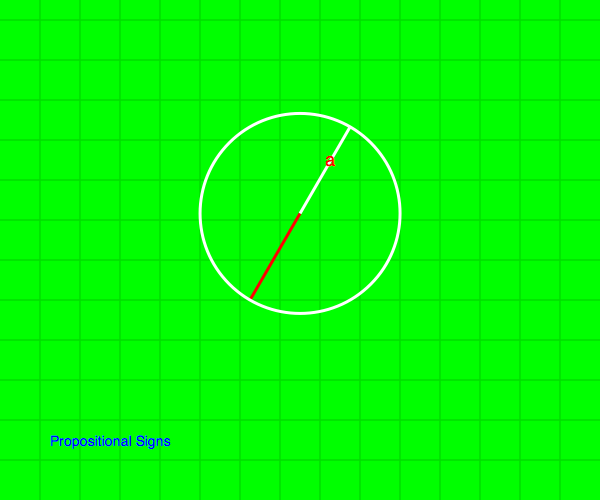
vector pointing to character a 30 degrees away from north
carriers of signs
- sound may be the carrier of signs
- light may be the carrier of signs
- earth, metal, stones, wood may be the carrier of signs
- carpets may be the carrier of signs
- clouds may be the carrier of signs
- wind may the carrier of signs
- oceans may be the carrier of signs
- rivers may be the carrier of signs
- birds may be the carrier of signs
- planets, moons, stars may be the carrier of signs
- skin may be the carrier of signs
- organs may be the carrier of signs
- body posture and gesture may be the carrier of signs
- elctro magnetic radar waves may be the carrier of signs
context of signs
- the carrier of the sign
- the temporal context of the sign
- the local context of the sign
- the emotional context of the sign
- the cultural context of the sign
- the logical direction of the sign (this is what this work is about)
- the motivation of the sign
motivation of signs
- to move you
- to suppress you
- to lift you
- to inform you
- to confuse you
- to disturb you
Enumeration of Vectors
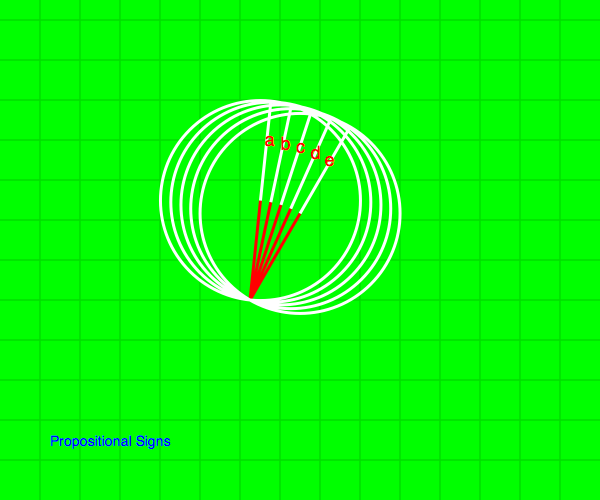
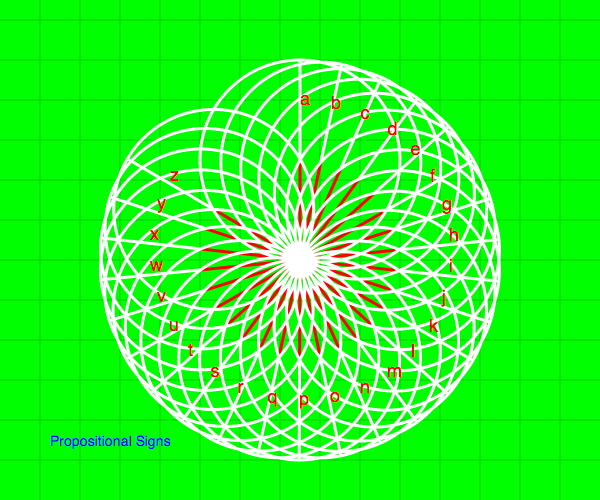
enumeration of the letters of the alphabet starting with a at 0 and then going clockwise by 12 degrees in the order of the alphabet.
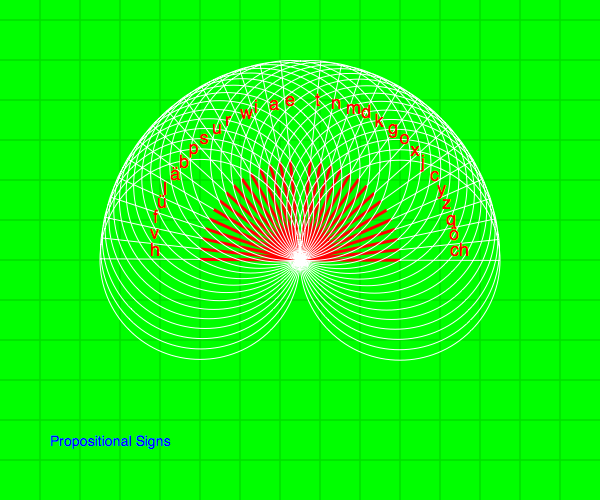
a variation of the enumeration of the letters of the alphabet (the distribution of the letters is influenced by the morse code).
Addition of Vectors
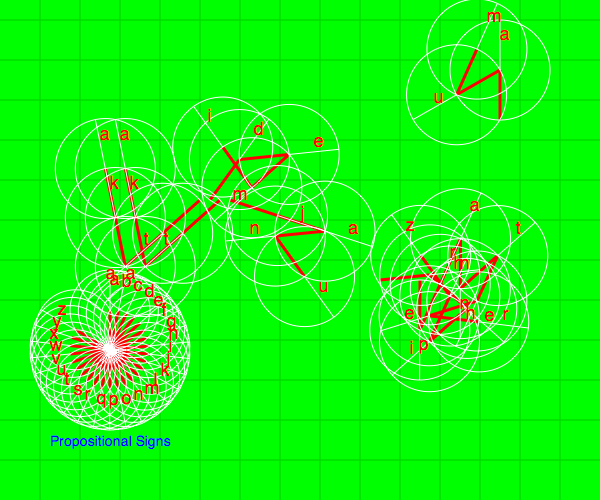
taka demi taka janu
heinzprantner
aum
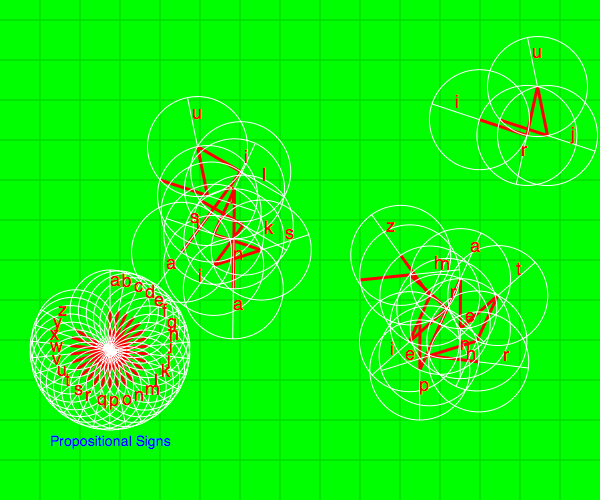
julia kissina
heinz prantner
juri
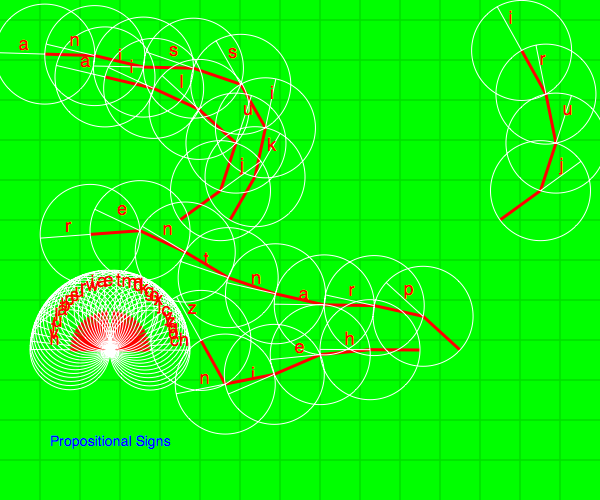
julia kissina
heinz prantner
juri
with different abc code
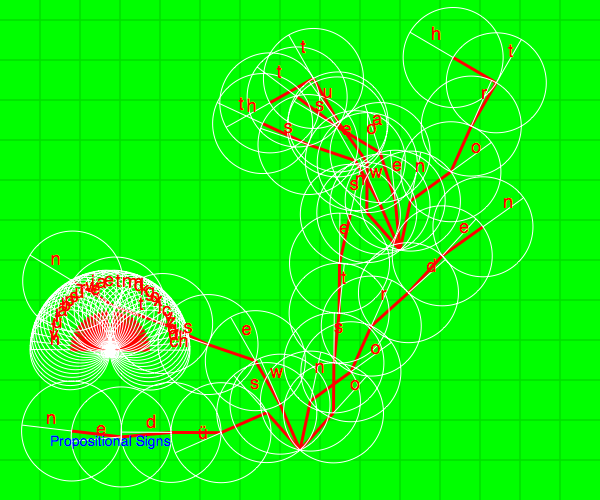
north, east, south, west
norden, osten, süden, westen
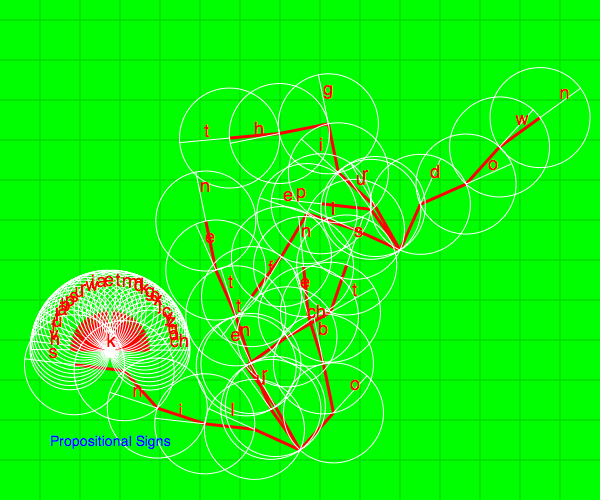
up, down, left, right
oben, unten, links, rechts
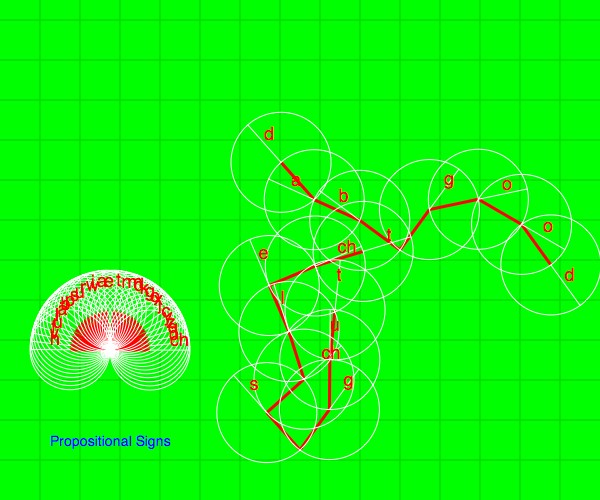
good, bad
gut, schlecht
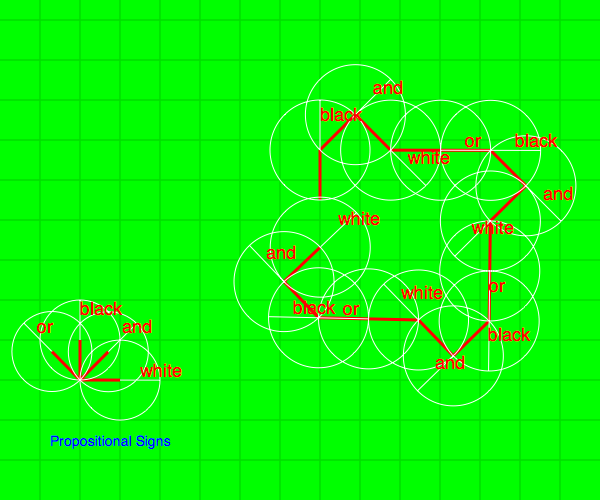
black and white
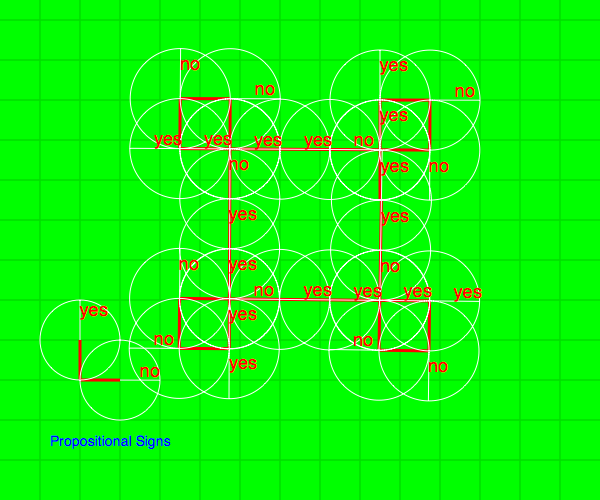
yes yes no no no yes yes yes yes no no no yes yes yes yes no no no yes yes yes yes no no no yes yes
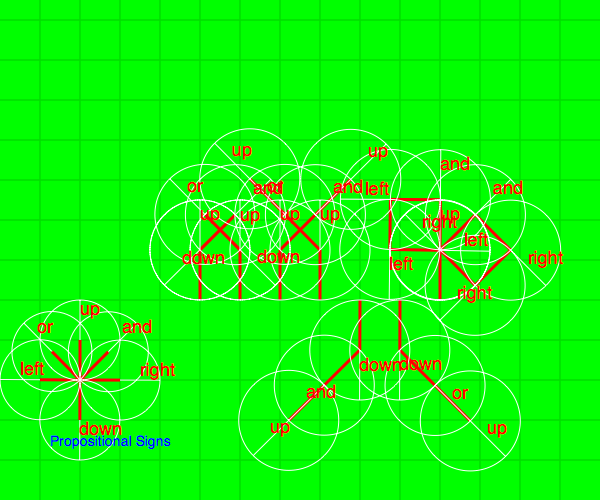
up and down or left and right
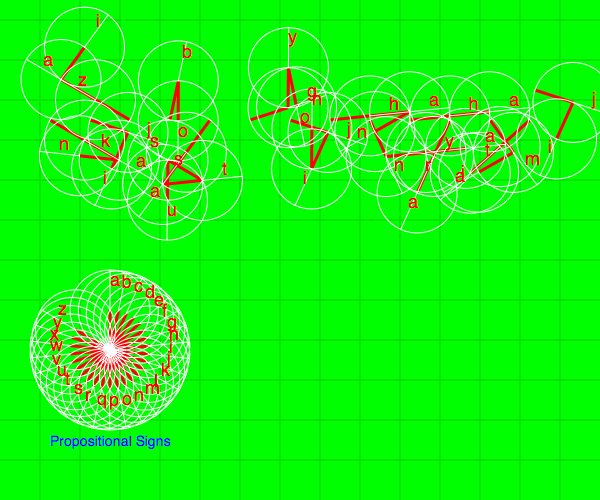
kan ji zai bo satsu. gyo jin han nya ha ra mi ta ji.
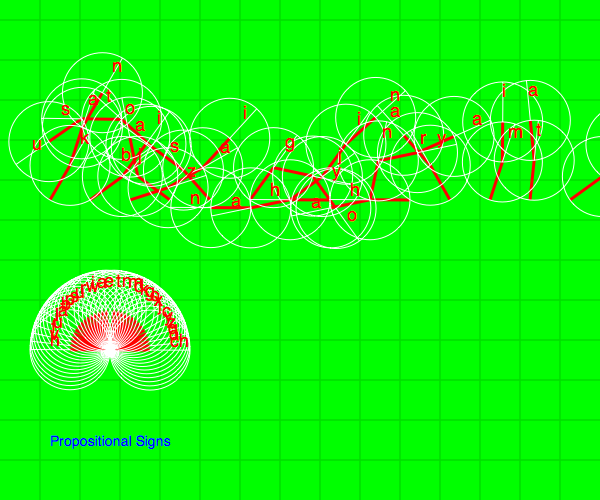
kan ji zai bo satsu. gyo jin han nya ha ra mi ta ji.
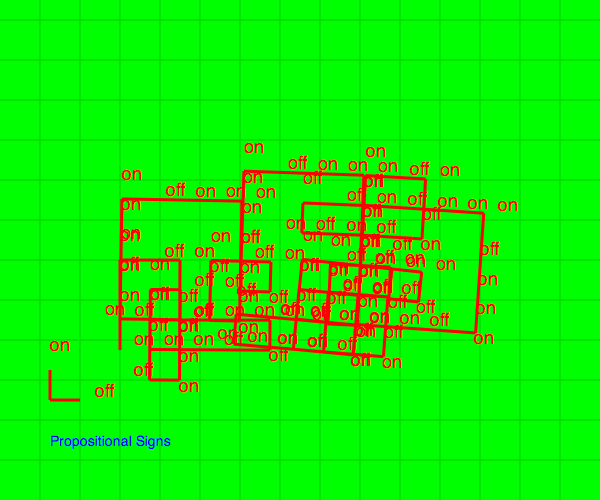
kan ji zai bo satsu with morse code
Forking of Vectors
Consider a computer algorithm which has to connect to a remote service based on local user requests, by using local and network resources to get there. The variables influencing the behavior are as follows:
- power
- user request
- user confirm pending
- active resoure
- passive resoure
- update needed
- service state
The following procedures apply:
- shutdown gracefully
- shutdown forcefully
- shutdown local
- activate resource - establish
- confirm
- update
- activate sevice - register
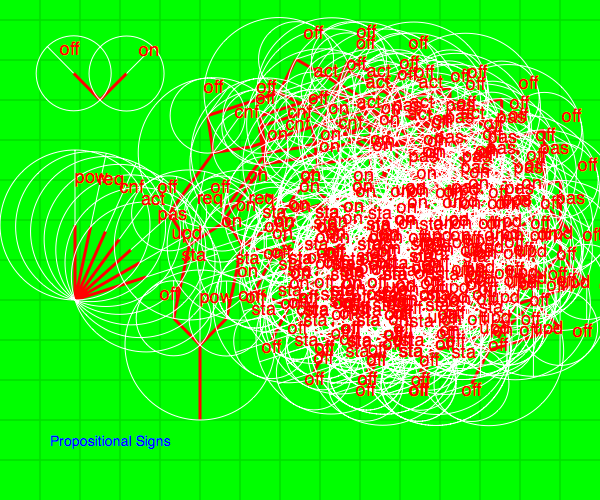
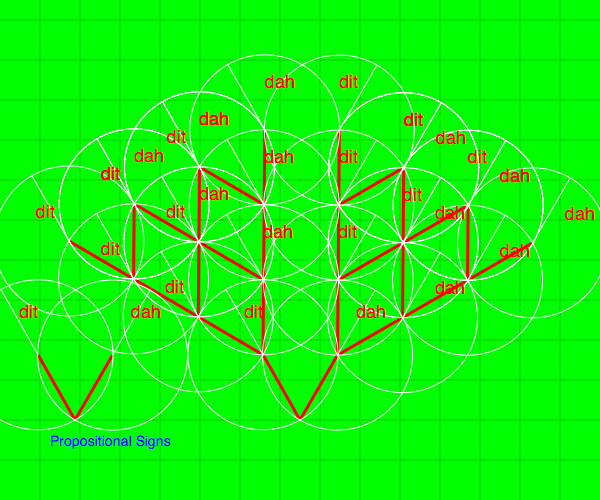
tree of morse signs dit and dah.